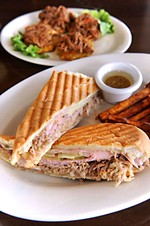Kitchen Education
There's More Than One Way to Become a Chef
Fri., June 22, 2001
When an aspiring chef decides to embark on this career path, a critical decision must first be made. He or she can attend cooking school or take the more common (and less expensive) apprentice route. That's the route that calls for working your way up through the ranks at restaurant after restaurant, learning and polishing your craft, until someone with power and/or money recognizes your talents, and you reach the exalted position of chef. For many the decision is preordained: Their financial constraints don't allow them to invest tens of thousands of dollars -- and several years of their time -- on formal training.
Regardless of where and how an aspiring chef acquires training, without the capacity for long hours of hot and harried work, he or she won't make it. It requires inspiration and initiative and a willingness to jump in there and contribute to the team by doing whatever needs to be done. Certification or not, a real chef has to be ready to start at the bottom and work his or her way up. It necessitates creativity and patience, and the innate ability to react quickly in routinely stressful situations.
Though the Austin restaurant market seems to be flooded with eager cooking-school graduates, there are still plenty of working chefs who acquired their proficiency through the on-the-job or apprentice programs. These self-taught chefs normally fall into two basic types: the accidental chefs (those who stumble into the profession and decide to pursue it), and the naturals (those who are driven from a relatively early age to produce great food).
The first group, the accidentals, is generally populated by students (and in Austin, occasionally musicians). Usually they are already in college, studying some academic field that they will seldom enter into professionally, and for them, working in a restaurant begins as nothing more than a paycheck; it's simply a financial means for survival. Somewhere along the way, however, the fledgling chef gets taken under the wing of a mentor and given a chance to be creative, or they work their way into a position with status and a bigger paycheck. Regardless of how they arrived, the accidental chef develops a desire for the fast pace of the kitchen and the instant gratification that comes from appreciation of their culinary talents. When the cooking bug bites, the accidental chef is born.
The second group, the naturals, is purer of purpose. Perhaps they grew up in families that had a genuine appreciation for good food, and learned the basics of cooking by a doting mother, aunt, or grandmother. Occasionally they grew up in a family where Mom could burn water without trying, and they learned to cook as a means of survival. Many natural chefs grew up in a family that ate out often at restaurants, and became fascinated by the pace of the experience going on around them, or their restaurant experiences might have exposed them to different styles of cuisines and piqued their culinary curiosity.
From an early age the natural can consume a cookbook ravenously. They seek out the strange and eclectic world cuisines, and can't wait to try the most esoteric of cooking methods and techniques. Natural-born chefs of my generation cut their teeth on Julia Child's French cooking program on public television, while the naturals of today are glued to FoodTV rather than MTV. Today's naturals can have hours-long debates and diatribes about whether Emeril is a culinary genius or a bone-headed charlatan.
And of course, there are hybrids of these two groups; I'm a perfect example. I grew up eating good simple food and working in restaurants for spending money in high school. I learned to cook out of self-defense. When I would get home in the evening from football practice, my two older brothers and my father would have eaten most of the supper that Mom had squirreled away for me, so I began to cook my own food with her guidance. I collected cookbooks and loved to cook for friends in college.
My professional career in restaurants had a fortuitous beginning. In 1975, I left a stressful position at the UT Co-op with an incredible amount of responsibility (product manager) and almost no pay ($3.83 per hour) to wash dishes at Pelican's Wharf, where I was paid the princely sum of $5 per hour plus tips and a free meal. All I had to do was show up and keep the dishes washed. Within four months, I had learned every staff position in the Wharf, and in a very short time, a friend and I were promoted to the restaurant-opening team of the expanding chain. That led to a five-year management position in San Antonio.
A burning desire to flee the droll Alamo City, coupled with a hot tip from a connected friend, led me back to Austin, running the kitchen of one of Austin's most innovative restaurants at the time, Clarksville Cafe. It was my first opportunity to flex my creative muscles and I have the owners to thank for nudging me in that direction.
To find out how they developed their chops and learned their craft, I talked to a handful of highly regarded Austin chefs who didn't go to formal cooking schools. These established chefs with no cooking-school diplomas have proven their capacity while learning on the job, and they're prime examples that it's not necessary to spend a fortune getting a prime culinary education. I wanted to know whether they would have changed the way they got their culinary education if given a healthy dose of hindsight.
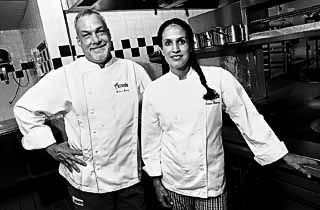
Teresa Wilson and Robert Brady
Chefs and co-owners, AquarelleWhen Teresa Wilson was growing up, her mother had a full-time job, so it became Teresa's responsibility to cook dinner for the five children and her parents three nights a week to help lighten the load. She slowly began to expand her repertoire of recipes as she realized how delicious real food could be. She left home to study chemical engineering and Middle Eastern studies in college, got married, had a kid, got a divorce, and took a full-time job at Bill Miller's BBQ, managing restaurants to support herself and her child.
A family tragedy forced her to accept more responsibility at home with a brother, so she needed a part-time job. She was hired at Basil's in the front of the house, and over time, took on the responsibility of catering and special functions. Bruce Silverman took her under his wing and taught her to cook on the line, and for 17 years she worked at Basil's doing whatever needed to be done.
"I see learning as a constant progression," she says now. "I learned from Alan, Marshall, and Bruce at Basil's and my partner Robert, and now chef Jacques Richard here at Aquarelle is my mentor. The learning process never ends. The staff in the kitchen is constantly learning new things. They're very enthusiastic ... the dishwashers are always wanting to know how we do things on the line, because they know some day they'll get the chance to move up."
Teresa's partner Robert was convinced by a friend's wife to quit working for UPS in Dallas to get a job waiting tables at a fancy restaurant there. As he became more proficient, he began to cook dishes at tableside, and caught the cooking bug. He had already started collecting cookbooks as far back as high school, but actually learned to cook while at UT. He waited tables for money while going to school, and says that "working with Teresa was my biggest influence. And then I was lucky enough to be able to get an apprentice position in Provence for nine months in '95, basically being a slave in the kitchen of an elite French restaurant," he says. "It was very high-pressure work, 14 hours a day. I didn't understand much French, but learned real quick what merde meant. That's what they would mutter under their breath when I messed up. It was invaluable working there, and I learn constantly from Teresa and Jacques here at Aquarelle. You never stop learning."
Both Teresa and Robert say that had they been dealt the right cards, they might have gone to cooking school. But they have no regrets. "School is school," Robert says. "It doesn't matter where you learn it. The schools can teach you the fundamentals, but they can't teach you how to work hard. [The students] all want to be Emeril with their name on a chef's jacket, but they don't want to work their way up from the bottom. I'd rather have a team player that's been at the bottom and knows the whole system here."
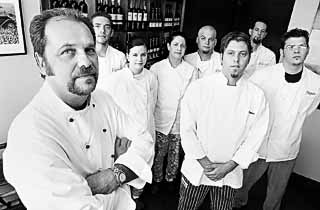
Alan Lazarus
Chef and owner, VespaioAlan Lazarus grew up in New York City, in a family that revolved around eating and food. They ate out often, and he was exposed to many types of cuisine at a tender age. "I grew up in a family whose life revolved around food, and learned from my mom, aunts, and grandmother," he recalls. "I started flipping pizzas at a place in Queens when I was 16. I would make Caesar salad for my school buddies during smoke breaks in high school. I worked my way through college working in restaurant kitchens, and the one non-food job I ever had, in a cosmetics company, I hated. I've worked in so many different restaurants in my life ... you name it."
Lazarus says that he never really had a mentor while growing up and learning his trade. "If I had it to do over again, I would have gone to Europe and worked my way around," he says. "The CIA (Culinary Institute of America) guys come out knowing the terminology and the basics, food safety, and the business side but the one thing they can't teach you is attitude. You have to have that creative edge, the desire -- you have to be compelled to want to do it, to work hard for long hours. They can teach you business management, but you have to learn the personal management on your own. You have to be able to sacrifice and know you have to work your way up through the stations."
Alan says that at Vespaio, they promote from the bottom up, from dish to pantry, pantry to grill. "The sauté station is where they all want to end up," he says, "that's the top."
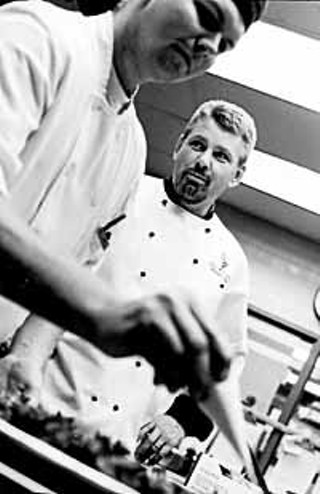
Elmar Prambs
Executive chef, Four SeasonsElmar Prambs of the Four Seasons has perhaps the most unique situation of the group. His mom wasn't a great cook, and his family seldom ate out. He began cooking for his brothers at the age of 12, and in high school was one of two boys taking home economics classes with 32 girls. He was trained in the European style, where apprentices work for three years at a hotel. "It was really hard work," Prambs says, "split shifts, 12 hours a day until nine at night, five days a week. Living in a dorm in the basement of the hotel. One day a week we had eight hours of classroom, and the seventh day we slept all day."
His chef was his mentor and surrogate father, and convinced him that as soon as he graduated, he should take off and experience the world. "He arranged a job for me in England with a Hilton hotel there. I worked there, and then got a job in Canada." After 10 years working in Hilton hotels throughout Canada, he came to Dallas. After working there for a year at a Hilton hotel, he landed the job with the Four Seasons here in Austin, where he has been for 14 years.
"We definitely promote from within," he says. "The corporate office hires my head assistant, and I get a new one to train every two years. And I rely on corporate for pastry, but everyone else moves up from lower stations. One of my best guys right now is a fellow that was once a dishwasher. He's one of my hardest and strongest workers. If you hire from outside, the rest of the staff realizes that no matter how hard they work, they'll never progress ... it's really bad for morale. I have four CIA guys working in the kitchen right now, but they all started near the bottom, and have worked their way up."
"Attitude is the one thing they can't teach you," he says about cooking schools, "and it's the main thing I look for when I interview people, not résumés. I quiz them over what they know, then I turn them over to the crew for training. It builds a stronger team. In Germany all of the instructors are older fellows that have seen it all, but at the cooking schools, many of the instructors are younger people. How much experience could they have?"
He still stays in touch with his original mentor, and will see him next week when he returns to Bavaria for several weeks. Prambs feels that learning is a constant process, and spends time at home researching recipes and reading the cooking magazines and cookbooks. "I've been here 14 years, and I still look forward to coming to work every day. At the entry level the hours suck and the pay's not that great, but it's a great job."
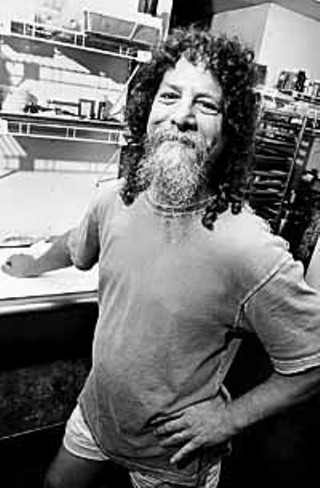
Raymond Tatum
Chef, Jean-Pierre's UpstairsRaymond Tatum of Jean-Pierre's Upstairs has been one of Austin's top chefs for the past 25 years, and it all happened by accident. He was a tree surgeon who had a bad fall, breaking his back. He decided that he needed a change, and reverted to his love of cooking. He had all of the basics down pat from his mother, who is a fabulous cook.
He started out at the old Split Rail and worked his way through several spots before hooking up with chef Emile Vogely (currently at the Tarry House) at Bloom's, one of the few Continental restaurants in Austin in 1977. "He taught me everything I knew back then, and through the years I always kept track of him to find out what he was cooking," Tatum says. They teamed up again at Jeffrey's in 1980, where Raymond ended up staying for the next 12 years. "Emile taught me technique and inspired me ... that son of a bitch can cook some food! I've got a lot of respect for him."
Ray has no regrets about not attending formal cooking schools. "I learned most of what I do from people that influenced me, then I adapted their style to my own. I read a lot of cookbooks and magazines, and look at ingredient lists for different combinations of things. In cooking schools they can't teach you how to react quickly to real-life kitchen problems. These guys come out knowing all the basics, but they lack creativity. That's something you can't be taught," says Tatum.
"Half of what I'm here for is to teach my crew what I've learned through the years," he says. "I'm not here to just crank out great food and manage the kitchen. We've got a good team here. I've got folks that show interest and initiative, and I move them up from dishwasher. Do that and they learn every station in the kitchen. It builds better teamwork, and I've always got somebody that can fill in at every spot."
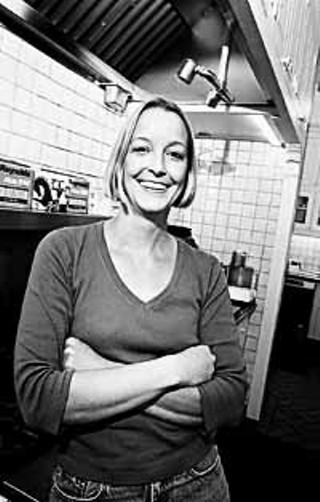
Sarah Bishop
Head chef, Governor's MansionSarah Bishop grew up in a food-oriented family that cooked a lot and ate out occasionally. "I had a fine arts degree and heard from a friend that Jeffrey's had a position open," she recalls. "I hounded them for several months until they hired me, and spent the next few months filleting fish and prepping. I moved to the line and Raymond [Tatum] basically taught me all of the basics." She was the sous chef for a year before the pantry position opened up, and she applied her arts background to the garde-manger station, putting out beautiful appetizers, salads, and desserts.
After bussing and waiting in the front while making jewelry on the side, she learned of a position at the Governor's Mansion, and spent two years there prepping and cooking mainly for social functions. She learned that it was critical to recognize the tastes and boundaries of the crowd she was serving to.
"Clements was straightforward, conservative, continental," she confides. "Richards was regional, nouvelle, healthier and lighter, more adventurous. Bush was American cuisine, Tex-Mex with an edge, more simple and straightforward. Perry is terrific ... he'll eat anything I cook, and really enjoys eating. He loves his vegetables, and is the clean-plate guy. But with each of them, I've had to learn their styles and be ready to adapt to all of the social functions and parties. It's a happening place."
AISD: Hospitality Academy Foundation
The big news from AISD is, beginning this fall, AISD's three-year-old Hospitality Academy Foundation program moves from Austin High School to Travis High School. This program, encompassing both culinary and hospitality classes, will have a new name that will be announced by AISD in the near future and a new chef-instructor, not to mention a shiny new 3,000-square-foot facility that includes a state-of-the-art kitchen lab, dining room, classrooms, and distance-learning equipment. The culinary arts classes at Crockett High School will be incorporated into the Travis program, and students from the Texas School for the Deaf will also participate. The program is open to all AISD high school students (except those living within the Bowie High School boundaries, who are eligible for the thriving Bowie culinary arts curriculum). Classes at the Travis facility begin in August, although the new construction won't be complete till October.
A noteworthy aspect of the program at Travis is the extraordinary level of support committed by local businesses, organizations, and individuals. While the program is housed on AISD property and administered by the school district, there is an advisory board composed of area chefs, culinary educators, and hospitality businesses. The Travis Education Foundation, chaired by Austin attorney John Blazier, is raising and coordinating the building funds. Various professionals are donating services, including architect Jim O'Neil of Pfluger Associates who designed the new facility, Jose and Rick Guerra who produced the working drawings, and the general contractor, Steve Hallmark. For more information about the culinary program at Travis, contact Pat Bell, AISD Career Specialist in Culinary and Hospitality, 414-2679. For information about the Travis Education Foundation, contact John Blazier, 476-2622.
Del Valle School District: Entrepreneur 101 Program
Del Valle High School is building a Carmelo's Restaurant right on campus, aided by the Texas Restaurant Association Education Foundation and Austin restaurateur Carmelo Mauro. The new restaurant, whose design was donated by Barbara Eckrote Design of Houston, should be completed by the time school starts this fall. The facility will function as the business and culinary laboratory for Del Valle's Entrepreneur 101 program where, under the guidance of faculty and business sponsors, students participate in all aspects of restaurant management and operation. Clif Dickerson is the chef-instructor for the culinary components of the program.
The year-old Entrepreneur 101 program is obviously striking a chord with Del Valle students. In its first year, approximately 200 students enrolled; reportedly, enrollment may double for the 2001 school year. For more information about Entrepreneur 101, contact Dr. Floyd Bevers, Del Valle Director of Careers & Technology, 386-3074.





